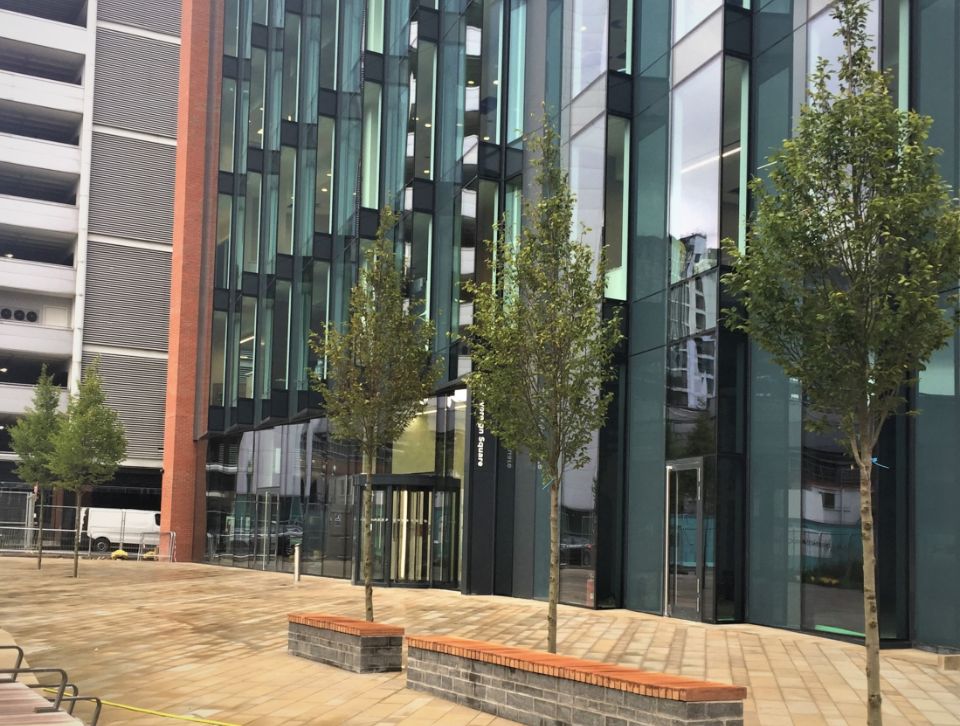“We specified Silva Cells as a requirement by the city of Palo Alto. They were used under the sidewalk to provide a healthy soil environment for Sycamore trees.”

In the Evergreen Park district of Palo Alto, California, a multi-purpose building was constructed in 2016. As part of the initiative, the designers wanted to embrace the inviting walkability of the Sherman Avenue environment — including planting eight new Sycamore trees to help mitigate the area’s heat island effect. The DeepRoot Silva Cell system was utilized to assist in the growth of healthy, shady trees, and the Silva Cells ensured that Palo Alto’s minimum soil requirement standards were met. Likewise, the project designers — embracing sustainability as a cornerstone principle — used on-site excavated soil in the Silva Cells, lowering the project’s carbon footprint by not resorting to external manufactured soils.

385 Sherman’s rooftop garden. Two of the eight Sycamore’s line the side of the building. Photograph courtesy of Kevin Quach.
Number of Silva Cells: 192 (3X)
Amount of Soil Volume Per Tree: 822 ft3
Number of Trees and Type: 8 Sycamore trees
Type of Project: Urban Canopy, Streetscape
Project Designer: Creo Landscape Architecture
Project Contractor: South Bay Construction Inc.
Installation Date of Silva Cells: September 2016
Project Timeline: 2015-2017
Featuring a number of “slow streets” dedicated to pedestrian accessibility that were created during the Covid-19 pandemic, the Evergreen Park district is a haven of restaurants and shops with easy access for walkers and cyclists. When a new 70,000 square-foot complex was being built in 2016, the developers wanted to embrace this aesthetic with trees that complement the surrounding bike parking and seating area.
The project planners faced a few challenges, including meeting the soil volume standards as outlined by the city of Palo Alto: medium-sized trees, like the eight Sycamores scheduled to be planted, required a minimum of 800 cubic feet of soil volume.
The DeepRoot Silva Cell system was the perfect solution.

A total of 192 (3X) Silva Cells were used in this project, which by itself provided 822 cubic feet of soil volume for each of the newly planted trees.
Todd Lansing, principal at Creo Landscape Architecture, was adamant about including the DeepRoot Silva Cell as a fundamental feature of the project. “We specified Silva Cells as a requirement by the city of Palo Alto. They were used under the sidewalk to provide a healthy soil environment for Sycamore trees. After a few years of growth, the trees are very healthy, vibrant, and we couldn’t be happier with their current condition.”
Prioritizing sustainability, the project team incorporated on-site soil in the Silva Cells. By excavating existing soil, compaction is loosened and the soil becomes more suitable for healthy tree root growth. Before being returned to the trench and its newly installed Silva Cells, the soil was mixed with compost, thereby eliminating the need to utilize external manufactured soils — this local approach thus greatly reduces the environmental impact of the project. Likewise, studies of Soil Profile Rebuilding — the process of loosening subsoil and adding natural materials like compost, tested by Susan Day of Virginia Tech University — suggest that tree growth within this environment flourished. For more information on this, read our blog on Urban Soil Reuse as Planting Soil.
Both Creo Landscape Architecture and the city of Palo Alto value work that builds community and creates friendly outdoor space for locals. The eight Sycamore trees along Sherman Avenue have grown big enough to offer benefits to residents and wildlife alike — including shelter for small mammals and birds.


Two of eight Sycamore trees at 385 Sherman Ave in June 2021.
Check out other DeepRoot project updates in Palo Alto here and here.


